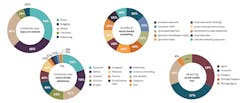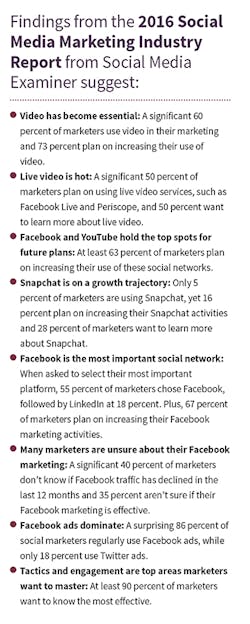It’s the 800-pound gorilla, frankly. Social media is the virtual bridge that connects with clients, informs audiences and allows companies to stay in front of loyal followers. Some companies take full advantage, yet some still prefer not to engage.
According to Eric Aune, owner, Aune Plumbing LLC, the fact that millions of consumers are using it every day, social media is extremely powerful. “Realizing its potential to reach your targeted customers is the first step in getting your name out there,” says Aune.
Some organizations have viewed social media as a “nice to have,” but not an essential part of their communications strategy. This seems to be changing as more and more are now making it a key part of their marketing effort. In fact, according to research from Social Media Examiner’s 2016 Social Media Marketing Industry Report, a significant 90 percent of marketers said that social media is important to their businesses.
“Having a social presence adds credibility to our brand. It shows current and potential customers that we are engaged in their world, and we want to be part of their lives,” says Ashley Tramm, content marketing specialist, Marketing Operations, Uponor.
For Jason Ridgeway, owner, Ridgeway Home Services, social media started out as a way to increase awareness of the company. “It became a ‘place’ where we promoted our work, as we are very proud of the work we do. It also has been a great way for us to stay in touch with members of the HVAC community such as suppliers, manufactures and support people.”
The beauty of social media is that it is real-time and offers the opportunity to share information instantly and stay connected with your customer. “We use social media primarily as a tactic to help build brand awareness with the intent of engaging with a targeted audience,” says Jon Orton, director, Marketing Operations, Uponor. Orton continues that social media allows customers to interact with the brand and, in turn, advocate for the brand. “Engagement is the crucial measure of success.”
By spending as little as six hours per week, 66 percent+ of marketers see lead generation benefits with social media.
Staying relevant is the key for some. “Our overall objective is to use social media to better communicate with our customers, which will allow for a direct line of communication between our current and future clients. By using social media it allows our company to stay relevant,” says Jason Fleming, marketing manager, Noritz America.
One can’t deny the power and reach of social media, but is there an ROI associated with it? According to the Social Media Examiner report, the ROI issue has plagued marketers for years. In 2015, 42 percent indicated they could measure ROI and in 2014, it was 37 percent.
By spending as little as six hours per week, 66 percent+ of marketers see lead generation benefits with social media. More than half of marketers with at least one year of social media experience were generating leads with social platforms, suggests the report.
“Statistics show that advertisements on social media have the ability to reach more customers at once than one sales person can in an average quarter. It also promotes a brand name which in turn creates customer loyalty, which many companies try to build through special services that differ from their competition,” says Fleming.
The report also showed that Facebook, Twitter, LinkedIn, YouTube, Google+, Instagram and Pinterest were the top seven platforms used by marketers, with Facebook (93 percent of users) leading the pack. All of the other platforms paled in comparison to these top seven. Some changes from last year saw Instagram jump from 36 percent to 44 percent.
Among the larger social networks, Twitter declined from 79 percent to 76 percent, LinkedIn dropped from 71 percent to 67 percent, YouTube went from 55 percent to 53 percent, Google+ declined from 56 percent to 49 percent, and Pinterest dropped from 45 percent to 40 percent.
Is this thing on?
I once attended a social media seminar where a panelist suggested that you would not get a single monetary sale related to social media. This can’t be true, can it?
“Using social media tactics in our planning effort helps us to stay engaged and connected with our customers. Several years ago a simple social media dialogue turned into a significant sale — the rest is history. It was a turning point for us and, today, we view every social media campaign as an opportunity to influence a prospect or build brand awareness,” says Orton.
According to Stephen Minnich, owner, Minnich Mechanical Design, “On every sales lead that comes our way, we ask the simple question ‘How did you hear about us?’ Invariably, it’s one of two answers: They were either referred to us or they found out about us via the Internet. I know for a fact that there have been sales due to our presence on social media.”
Aune says that many individual sales for his plumbing and heating business can be directly linked to interactions and brand awareness made possible by social media. “The only thing difficult to quantify would be how many jobs have been closed where first contact was not made through social media when the customer was already aware of our presence there.”
Breaking bad
Social media does have negative aspects associated with it. For example, your company is under the social microscope and once it’s out there, it’s out there, so think before you hit send. The information you share is instantaneously accessible, and if a follower is in a foul mood, for example, brand bashing could be an end result.
According to Ridgeway, one downside to social media is having a childish owner or competitor try and belittle your company. “We had one owner posting bad reviews on our page and was just trying to steer people his way. Jealousy is the best flattery, but that kind of activity is a product of the keyboard warrior mentality you find online.”
Although a negative aspect of social media is the negative user interaction and user feedback, it can be used as a teaching and a potential customer service tool. A lot of companies struggle with whether they should delete or hide negative posts and it’s a big topic of debate in the social media world. “Personally, we like to keep negative posts, but be diligent about responding and addressing negative matters. Our logic is that we want the public to see that we care and we are willing to address both negative and positive comments head on,” says Fleming.
Be prepared for the level of time and resources commitment to support social media. “If your business engages in social media, you are setting an expectation with your audience that you will respond to their comments in a timely manner,” says Orton.
Market segmentation
Bridging the behaviors between various generations and their acceptance of various socialNoritz’s Fleming agrees, “It’s really about segmentation of your audience. The younger generation is eager to consume content, so you have to make sure to cater to them. The older generation is still in the process of assimilating into the social media platforms, so you have to make sure to usher them in and welcome them onto the platforms.
“We also see a lot of variety among the different platforms since each one serves its own purpose,” adds Fleming. “For example, LinkedIn is a very professional/trade oriented platform, whereas Facebook tends to be a mix of professional and consumer. The audiences are the same as our non-social network targets we just have to realize that social media audiences are a little more eager to consume interactive media such as online videos.”
Engagement & tracking
Monitoring engagement through the various online tools is really a big part of social media management, says Fleming. These tools help you cover all three of these aspects and keeping a close eye on your analytics will truly provide you a “pulse” of your community.
Monitoring engagement is likely one of the best signals that your message is received by your audience. Your message is on target if the targeted audience is engaging with your company. It also aligns with the No. 1 rule of selling — know your customer. “Using social media as part of our communications strategy helps us to stay engaged and connected with our customers,” says Orton.
If, over time, your organization builds rapport and trust, you will have an immediate outlet to connect with your audience.
Knowing your audience is critical. Tracking and delivery have been made simple with tools available from social media outlets. “The content of your message is what will ultimately dictate the response,” says Aune.
Building a social network improves your communication strategy. If, over time, your organization builds rapport and trust, you will have an immediate outlet to connect with your audience, suggests Orton. “Social media will become essential as personalization becomes more common in targeted campaigns. Building a social network opens that door to engaging at a new level with your customers.”
Minnich, perhaps, sums it up best. “Keep posting. Keep the message on point. Let people know what defines you in the most abbreviated way possible,” he says.
“Social media is part and parcel in our efforts to become a well-recognized company in the hydronic industry and it will continue to be,” continues Minnich. “It will become an even bigger aspect of our marketing strategy as we grow. And, you can’t beat the price. For all intents and purposes, it’s free. It would be foolish to not take advantage of that.”




